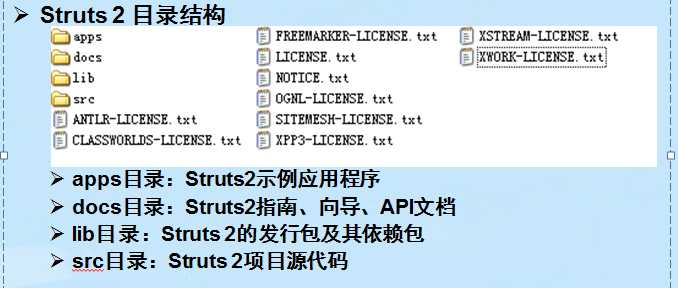标签:
Struts框架汲取了Struts的优点,以WebWork为核心,拦截器,可变和可重用的标签。
第一步:加载Struts2 类库:

第二步:配置web.xml
<?xml version="1.0" encoding="UTF-8"?> <web-app version="2.5" xmlns="http://java.sun.com/xml/ns/javaee" xmlns:xsi="http://www.w3.org/2001/XMLSchema-instance" xsi:schemaLocation="http://java.sun.com/xml/ns/javaee http://java.sun.com/xml/ns/javaee/web-app_2_5.xsd"> <welcome-file-list> <welcome-file>index.jsp</welcome-file> </welcome-file-list> <!-- 配置Struts2过滤器 :拦截请求 --> <filter> <filter-name>Struts2</filter-name> <filter-class>org.apache.struts2.dispatcher.ng.filter.StrutsPrepareAndExecuteFilter</filter-class> </filter> <filter-mapping> <filter-name>Struts2</filter-name> <url-pattern>/*</url-pattern><!--‘/*‘ 过滤所有请求 --> </filter-mapping> </web-app>
第三步:开发视图层页面(提交表单页)
<%@ page language="java" import="java.util.*" pageEncoding="UTF-8"%> <% String path = request.getContextPath(); String basePath = request.getScheme()+"://"+request.getServerName()+":"+request.getServerPort()+path+"/"; %> <!DOCTYPE HTML PUBLIC "-//W3C//DTD HTML 4.01 Transitional//EN"> <html> <head> <base href="<%=basePath%>"> <title>Struts2Demo</title> </head> <body> <h1>HelloWorld Struts2</h1> <hr> <form action="LonginAction" method="post"> <p>用户名:<input type="text" name="username" /></p> <p>密 码:<input type="password" name="password" /></p> <p><input type="submit" /></p> </form> </body> </html>
package dao; /** * 用户操作接口 * @author Administrator * */ public interface UserDao { public String login(String username,String password); }
package biz; /** * 用户业务接口 * @author Administrator * */ public interface UserBiz { public String login(String username,String password); }
package biz.impl; import biz.UserBiz; import dao.UserDao; import dao.UserDaoImpl; public class UserBizImpl implements UserBiz { //创建dao层对象 UserDao userdao = new UserDaoImpl(); /** * 调用dao层方法 */ public String login(String username, String password) { return userdao.login(username, password); } }
package dao; public class UserDaoImpl implements UserDao { public String login(String username, String password) { String str = ""; if(username.equals("msit") && password.equals("123456")){ str = "success"; }else{ str = "error"; } // TODO Auto-generated method stub return str; } }
第五步:开发控制层Action
package Action; import java.util.Map; import javax.servlet.http.HttpServletRequest; import javax.servlet.http.HttpServletResponse; import javax.servlet.http.HttpSession; import org.apache.struts2.ServletActionContext; import biz.UserBiz; import biz.impl.UserBizImpl; import com.opensymphony.xwork2.ActionContext; import com.opensymphony.xwork2.ActionSupport; /** * 登录控制器 * @author Administrator * */ public class LoginAction extends ActionSupport{ /*值栈:页面可以直接获取*/ String username;//form表单name;进行封装 String password;//form表单name;进行封装 //创建Biz层对象 UserBiz userbiz = new UserBizImpl(); /* (non-Javadoc) * @see com.opensymphony.xwork2.ActionSupport#execute() */ @Override public String execute() throws Exception { // TODO Auto-generated method stub System.out.println(username+"==="+password); /*解耦(降低依赖)方式;基于Map集合*/ ActionContext ac = ActionContext.getContext(); /*得到request*/ Map request = (Map) ac.get("request"); //request.put("username", username); /*得到session*/ Map session = ac.getSession(); /*得到application*/ Map application = ac.getApplication(); //=================================================== /*耦合(依懒性)方式*/ HttpServletRequest request2 = ServletActionContext.getRequest(); HttpServletResponse response = ServletActionContext.getResponse(); HttpSession session2 = request2.getSession(); //request2.setAttribute("username", username); /** * struts默认提供了五个状态字符串 */ return userbiz.login(username, password); } /** * @return the username */ public String getUsername() { return username; } /** * @param username the username to set */ public void setUsername(String username) { this.username = username; } /** * @return the password */ public String getPassword() { return password; } /** * @param password the password to set */ public void setPassword(String password) { this.password = password; } }
第六步:配置struts.xml(核心文件);可以参照struts-default.xml
<?xml version="1.0" encoding="UTF-8"?> <!DOCTYPE struts PUBLIC "-//Apache Software Foundation//DTD Struts Configuration 2.3//EN" "http://struts.apache.org/dtds/struts-2.3.dtd"> <struts> <!-- 配置包信息 --> <package name="default" namespace="/" extends="struts-default"> <!-- 配置Action:关联Action JavaBean --> <action name="LonginAction" class="Action.LoginAction"> <!-- 指定返回的视图 ;默认使用转发--> <result name="success">success.jsp</result> <result name="error">error.jsp</result> </action> </package> </struts>
第七步:处理完逻辑之后返回相应的字符串success、error跳转到相应的页面
<%@ page language="java" import="java.util.*" pageEncoding="UTF-8"%> <% String path = request.getContextPath(); String basePath = request.getScheme()+"://"+request.getServerName()+":"+request.getServerPort()+path+"/"; %> <!DOCTYPE HTML PUBLIC "-//W3C//DTD HTML 4.01 Transitional//EN"> <html> <head> <base href="<%=basePath%>"> <title>My JSP ‘success.jsp‘ starting page</title> <meta http-equiv="pragma" content="no-cache"> <meta http-equiv="cache-control" content="no-cache"> <meta http-equiv="expires" content="0"> <meta http-equiv="keywords" content="keyword1,keyword2,keyword3"> <meta http-equiv="description" content="This is my page"> <!-- <link rel="stylesheet" type="text/css" href="styles.css"> --> </head> <body> ${username } 登陆成功!!! <br> </body> </html>
<%@ page language="java" import="java.util.*" pageEncoding="UTF-8"%> <% String path = request.getContextPath(); String basePath = request.getScheme()+"://"+request.getServerName()+":"+request.getServerPort()+path+"/"; %> <!DOCTYPE HTML PUBLIC "-//W3C//DTD HTML 4.01 Transitional//EN"> <html> <head> <base href="<%=basePath%>"> <title>My JSP ‘error.jsp‘ starting page</title> <meta http-equiv="pragma" content="no-cache"> <meta http-equiv="cache-control" content="no-cache"> <meta http-equiv="expires" content="0"> <meta http-equiv="keywords" content="keyword1,keyword2,keyword3"> <meta http-equiv="description" content="This is my page"> <!-- <link rel="stylesheet" type="text/css" href="styles.css"> --> </head> <body> 登录失败 <br> </body> </html>
注意:
配置struts2 1、加入类库(jar包)—从应用实例当中拷贝 2、在web.xml中配置过滤器 <!-- 配置Struts2过滤器 --> <filter> <filter-name>Struts2</filter-name> <filter-class>org.apache.struts2.dispatcher.ng.filter.StrutsPrepareAndExecuteFilter</filter-class> </filter> <filter-mapping> <filter-name>Struts2</filter-name> <url-pattern>/*</url-pattern><!--‘/*‘ 过滤所有请求 --> </filter-mapping> 3、编写页面index.jsp 4、配置控制器(action) LoginAction 继承 Actionsupper 重写父类的excute()方法 5、配置struts.xml(核心文件);可以参照struts-default.xml 6、处理完逻辑之后返回相应的字符串success、error跳转到相应的页面
标签:
原文地址:http://www.cnblogs.com/wlx520/p/4581877.html